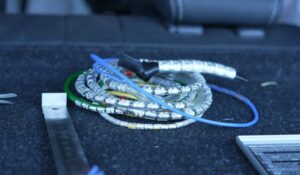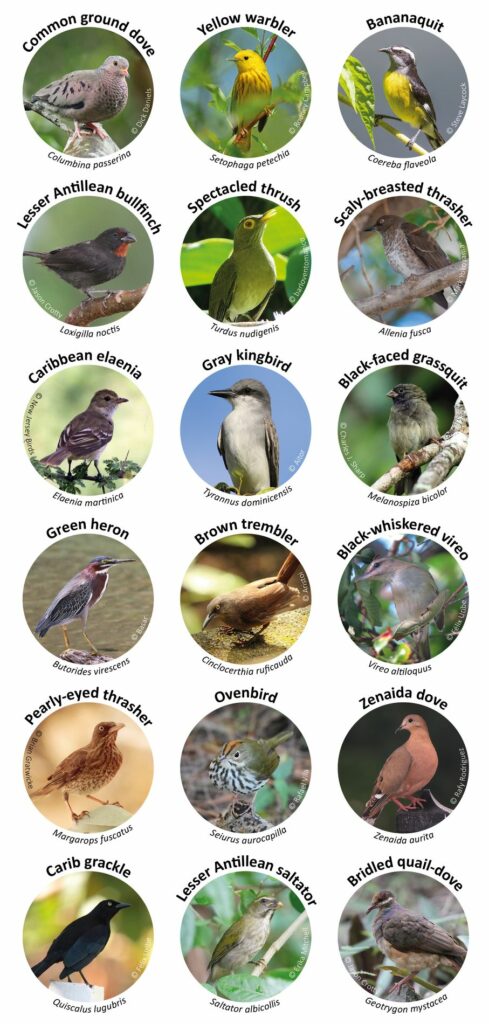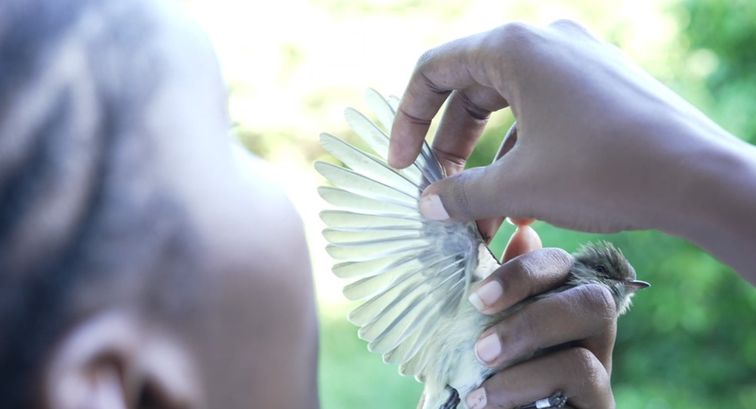The PROSPOVERG project came to an end, along with two years of close monitoring for the fauna of the Poyen forest, in Guadeloupe. The birds in particular were monitored using three different methods, with a triple objective: to better understand the biodiversity of this forest, to assess the effectiveness and complementarity of the different monitoring methods used, and to train students in these specific techniques.
Knowing the abundance of individuals of certain species or populations is important to define their conservation status, and to adapt management measures if necessary. Studying the demographic parameters of several species in a specific place is also useful to better understand their ecology: interactions (predation, competition), differences in lifestyle (diurnal vs nocturnal), sociability or preferences in terms of habitat.
In the field, several techniques can be used. During the PROSPOVERG project, three monitoring methods were thus deployed to study birds, but also mammals in the dry forest of Poyen, in Guadeloupe: a capture-mark-recapture (CMR) technique, the set-up of camera traps, and the use of acoustic recorders.

Rings for different species of birds
The first technique (CMR) consisted of installing nets to capture flying birds. Eight nets, each 24 meters long, were deployed once a month for two years, always in the same places. Each animal that was captured provided valuable information: species, size, weight, sex and stage of development. A ring was installed on birds legs, with a unique number on it to identify them upon subsequent captures.
The other two methods are passive. Automatic devices were installed in the same areas as the nets, for four months. With camera traps, we obtained images of each animal that passed in front of them, as cameras automatically took pictures when detecting a movement. Acoustic recorders captured ambient sounds, including the songs of birds whose species were then identified. This time, the recording was programmed: every hour for 24 hours, the device turned on for 10 minutes.
These three methods are illustrated in the following video (French with subtitles), shot in the field, and explained by Christopher Cambrone, scientific coordinator of the project.
After two years of monitoring, it is time to take a look at the results. The analysis of the data over the four months during which the three techniques were all deployed confirms their complementarity. Indeed, nets only capture birds in flight, while the cameras are installed 20 cm from the ground, and therefore only target animals using the lower stratum of the forest. Sound recorders, for their part, can lead to the identification of species that vocalize.
Over the two years of monitoring, 27 species of birds were detected by the three methods. Among them, birds belonging to 18 different species were captured, and nearly 800 individuals were ringed. During the four months it was in place, the acoustic monitoring proved very effective and detected 26 species, while only 10 species of birds were photographed and as many species were captured during the same period.
Among the species of interest, three endemic birds to the Lesser Antilles have been listed in the forest of Poyen, the Scaly-breasted thrasher (Allenia fusca), the plumbeous warbler (Setophaga plumbea) and the Lesser Antillean saltator (Saltator albicollis), as well as a species classified as endangered in Guadeloupe, the White-crowned Pigeon (Patagioenas leucocephala).
The analyzes also assessed the abundance of these species and their distribution in the Poyen forest. Mammalian data were also collected using camera traps: mongooses, raccoons, dogs, cats and rats. These data were compared with those of birds to better understand the risks of predation, in particular by evaluating the spatio-temporal overlaps (i.e. the possibility that two species will be in the same place at the same time of the day). Mongooses, the only diurnal invasive alien mammal species, were particularly photographed, and therefore pose a significant risk to the avian fauna of this forest.

A total of 18 different bird species were captured in the nets during the 24 months of monitoring.
The project started at the end of 2020 as part of a partnership between AMAZONA (www.amazona-guadeloupe.com), an association contributing to the study of Guadeloupe’s avifauna and the dissemination of knowledge, and Caribaea Initiative. It involved more than thirty people, and enabled the training of two master’s and two PhD students. Several ornithological field trips for the general public and for students have also been organized as part of this project.
The PROSPOVERG project was funded by the Office Français de la Biodiversité. We would also like to thank the Office National des Forêts, the Réserve Biologique Dirigée du Nord Grande Terre and the Conseil Départemental de Guadeloupe for allowing us to carry out the monitoring in the Poyen forest.


